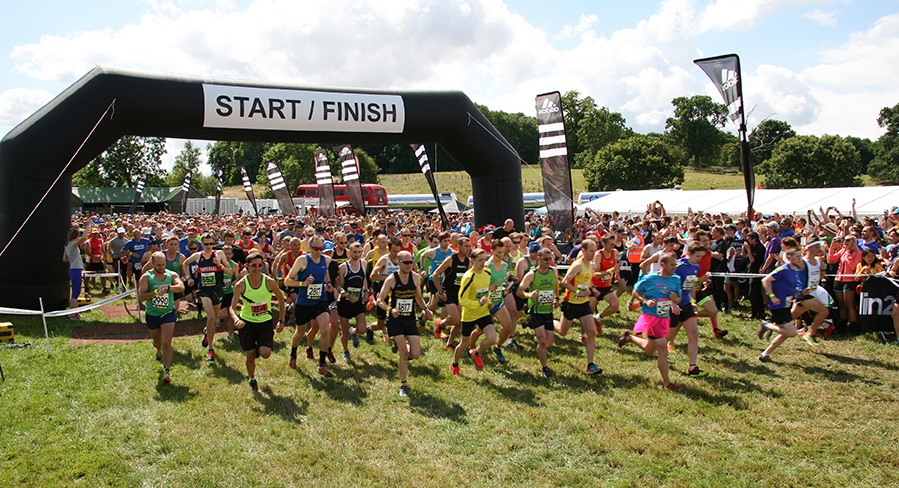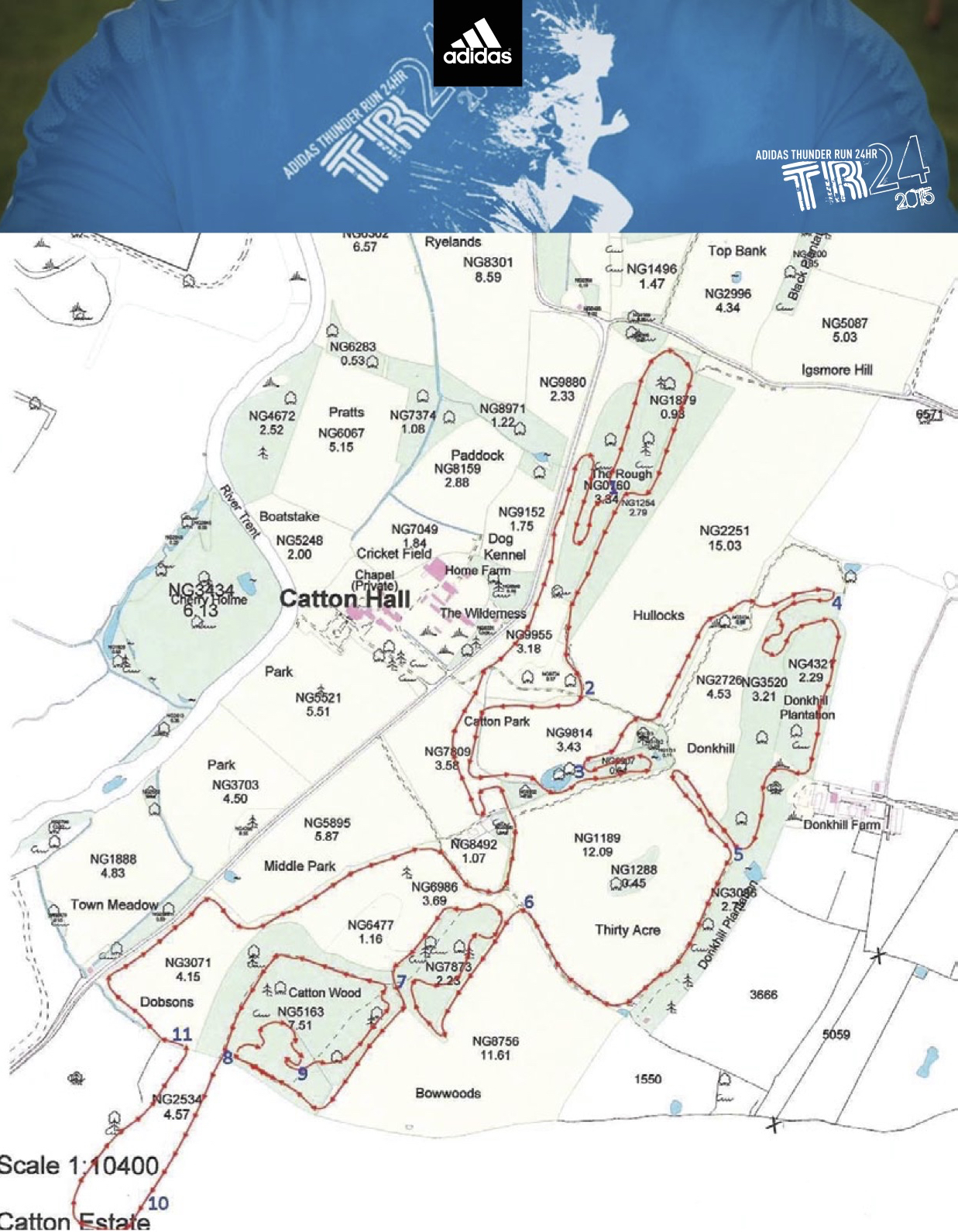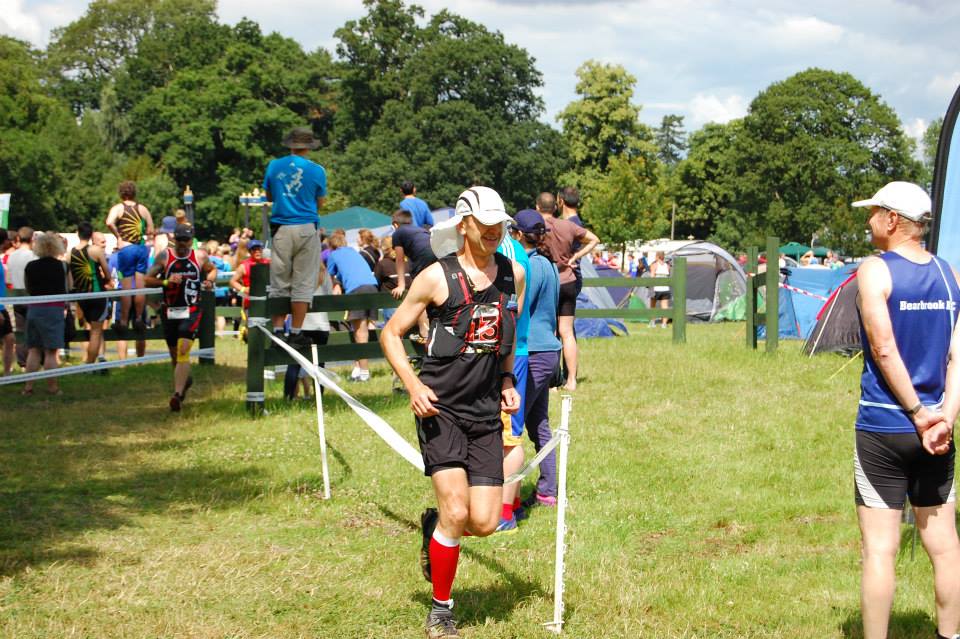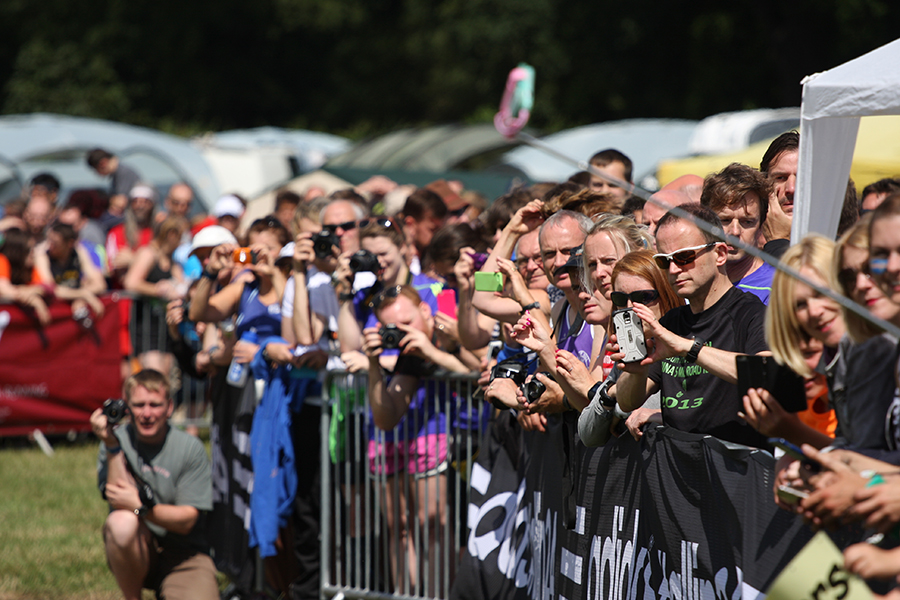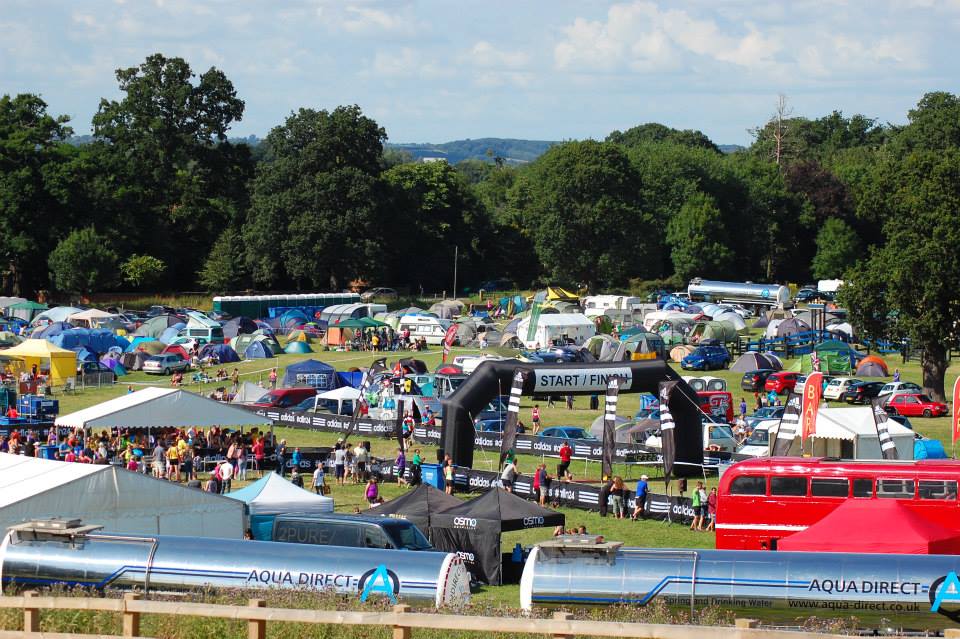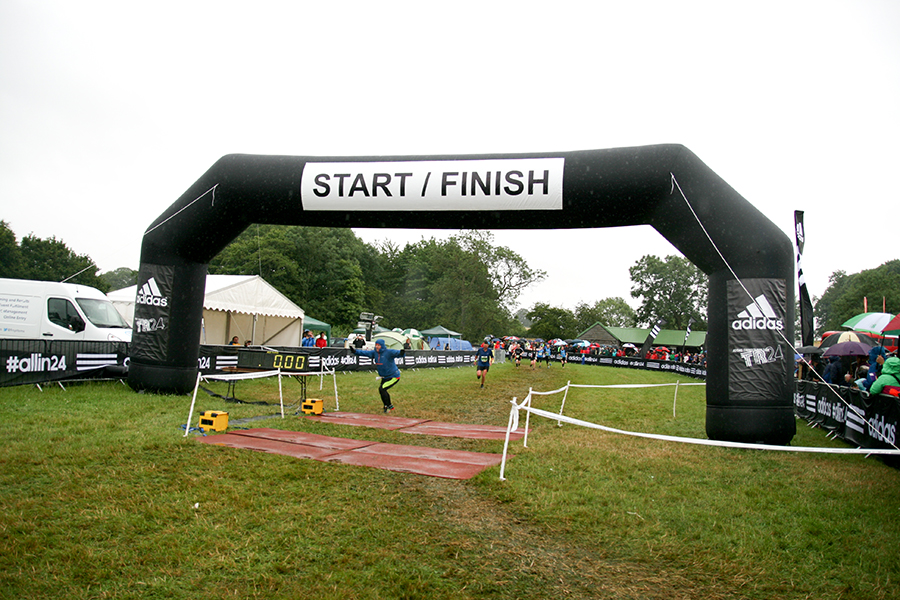Adidas Thunder Run 24 – 2015
A Race Against Time
The Adidas Thunder Run 24 (TR24), now in it’s 7th year, is a 24 hour off-road race over repeated loops of a 10km cross-country circuit at Catton Park, Derbyshire. The track twists and turns across varied terrain with boggy ground, stony paths, open fields, steep hills and mixed woodland complete with tree stumps and roots.
This competitive race is very popular with running clubs from all over the country who enter relay teams of 2, 5 or 8 runners. This ensures a lively festival atmosphere with great support in the camping areas through which the course passes on each and every lap.
But I, along with 116 other competitors, was here to race in the SOLO category. How far could I run, on my own, in 24 hours?
Unlucky for some!
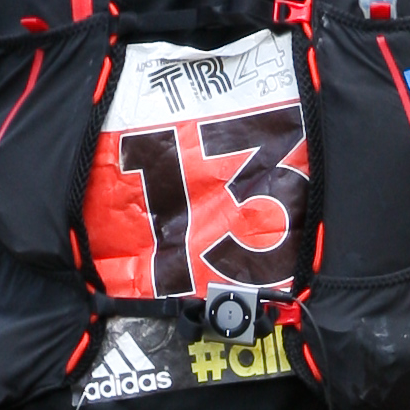
I had an idea it was going to be my race when they handed me race number 13 at registration!
At 52 years old and with a goal to win a race outright rather than the age group prizes that I sometimes win, I ran TR24 Solo this weekend and came up trumps. Over the moon! Thank you to everyone who didn’t know me but cheered me onwards throughout. I won by two clear 10k laps also breaking the course record by two laps. Now I can retire!
A new course record
Ready?
This was my first ever attempt at the 24 hour format so my preparation started with a bit of research:
1 – check out the previous 5 years of TR24 results
I found that every year the race had been won with a distance of 20 laps (200km). My very first reaction was that this seemed to me to be a little bit short for 24 hours. But a quick look at the lap times of the winning 8-men relay teams revealed slower than expected 10k times for some of the country’s best club runners. This gave me an immediate insight that this 10km loop was not a fast, flat tarmac 10km but a somewhat challenging run even for just one lap.
Next I researched the previous winners using the Ultra Marathon Statistics and the British Athletics Power of 10 websites. What sort of runners were they? How did I compare? Could I be competitive against them? What did I need to do to be competitive?
2 – check out this year’s competition
I had quick look for any returning entrants (assuming they might be coming back to run a further distance) and I wanted to know were there any previous winners in the field? The answer was “yes” to both – over half the field were previous solo entrants and a previous male and female winner were on the start list. Pre-race it looked to me that Kevin Doyle could be a possible favourite. He had 12 and 24 hour racing wins and faster PB’s than myself at 5k through marathon. In 2011 he had won the Thunder Run. In 2013 we had both raced Rowbotham’s Round Rotherham – Kevin placed 2nd whilst I was 10th. In 2014 Kevin had won the RRR.
3 – declare my race goal
My goal for the TR24 was to win the race. To come first. To win my first ever running race.
Goals such as “finish the race”, “run a sub 3 hour marathon”, “run a negative split” pit ourselves against the clock or against our own PBs. Achieving these goals is, in some ways, more under our own control than a goal like “win the race” which is dependant not only on our own performance but also on those of the other competitors who toe the start line that day. I was dreaming big with this race but also believed that I could do it.
This type of race goal should be shared with your running coach but probably not with the other competitors or even your club mates. I shared this goal with only one person before the start of the race – my wife. I had already spent a week away at the beginning of the year on the Pennine Way and less than a month after the Thunder Run I would be off to Chamonix for my first Ultra-Trail du Mont-Blanc. I had to justify to my family why I needed to disappear to Derbyshire for the weekend. She was well aware of my competitive long term goal to win a race outright (rather than one of the age group prizes I sometimes come home with) and so I only had to share a few word of explanation with my wife to get the weekend pass I needed:
“I think I could win it”
Get set
Before TR24 I’d only twice run for longer than 24 hours, first at the 2014 Lakeland 100 and then in January this year on the 268 mile Spine Race. Both races involved navigation and carrying suitable mountain and winter equipment. The TR24 was on a marked course where every 10km I would be back crossing the start/finish line – so no navigation or need to carry much food and water .
Solo competitors have their own trackside camping area immediately adjacent to the start/finish gantry so it would be easy to collect food, water, head torch, layers or even change shoes without losing too much time. I decided I would wear my Salomon S-LAB Sense Ultra Set, a lightweight, minimal race vest, so I could easily carry water, gels, s-caps and have the option to feed whenever I felt like it rather than trying to regiment my feeding to be once a lap. I planned to carry enough for perhaps a couple of laps at a time and then reload from my trackside stash as I went.
There would be no feed tables of the sort you find in most ultras, so I had to provide all my own food for the race. When I arrived in the solo camping area I rigged up a tarp shelter with all my supplies so I could easily grab anything I needed whilst racing. I knew that there was a mid-lap water table on the course and my own running club had a large camping area adjacent to the the course at about 2.5 km and could assist by refilling water bottles, but for me to be as competitive as possible meant that I didn’t stop for more than a few seconds. Therefore under my tarp shelter I had 24 bottles pre-filled with either sports drink or water and masses of gels, bars, fruit and snacks. It was a simple matter to drop an empty bottle and litter and pick up a new supplies very quickly.
I’ve found hot food and drinks to be invaluable when racing at the night and during the winter in the English Fells and Welsh mountains but I figured that on a warm July evening I could probably get away with just cold drinks and a predominantly gel based diet. Just in case I was wrong, I had some really good dehydrated expedition meals that I’d used on the Spine Race and my jetboil stove in the back of my car – I could have boiled water and carried away a hot meal and spoon to eat on the go in something under 3 minutes. There was also a thermos flask filled with freshly made espresso that I’d brewed just 30 minutes before the start of the race.
It might seem extreme to be thinking about how to save seconds here or minutes there in a 24 hour race where my winning average pace was – something like a slow jog. But remember that the clock never stops. Races can be won or lost by seconds. And stopping and starting can be quite a tricky thing to do on tired legs.
“Go SOLO!”
Despite the previous night’s heavy rain, just before midday on Saturday we found ourselves on the start line in the hot sun. There were a lot of runners. As well as the male and female solo categories there were male pairs, female pairs, mixed pairs, teams of 3-5: male, female or mixed and mixed teams of 6-8 runners. Adjacent to the start finish line is the handover area where the relay teams swap runners on each lap and it was already full of team runners. Other runners and their families lined the course to watch the start. I deliberately stood a few rows back from the line as I was very cautious to make a conservative start to the race and not get dragged along by the fast pace of the relay teams. Still though I was closer to the front than many as I didn’t want to get held up where the track narrows after a km or so where it climbs through the trees for the first time.
12 noon and off we charged.
As soon as we reached the first path through the woods I knew my shoe choice of studded trail shoes had been correct as runners in road shoes started to slip and fall around me. A club mate, Patrick, racing in the pairs category and so running a quicker pace than myself, soon passed me on drier ground but as soon as we reached the next muddy section I caught up with him as he impersonated an out of control ice skater. The afternoon was hot and as the laps passed the ground underfoot became firmer. I took it as steadily as I could. I probably ran the first 30k a bit faster than I should have but its hard to run slowly when you are feeling fresh.
There was constant, tremendous support for solo competitors from spectators and other runners alike, and a never ending call of encouragement:
“Go Solo!”
Nothing much happens
I have heard it said that nothing much happens in the first 15 or 20 hours of a 24 hour race. That it is all about just steadily knocking out the laps. Being patient. Biding time. Feeding. Drinking. Keeping it steady. Conserving energy.
Now this all makes 24 hour racing sound a bit boring.
Boring – it is not!
And it is not boring. Plenty happens. I think what they are saying is that you can’t really do anything exciting in a heroic sort of way, early on in a 24hour race. Sprinting from the start line to run the first 10k at 6 minute miling isn’t going to be a good idea. Maybe if you were a live TV sports commentator, you would have to waffle quite a bit to fill your airtime for the first 20 hours or so.
However running at the more pedestrian pace required by 24hour racing (Yiannis Kouros 24 hour World Record equates to an average 7:38 minute miling) does give you plenty of time to be observant and enjoy your surroundings. And the terrain suited me: short sharp hills, tree roots, grass, mud, and twists and turns. I chatted, ate drank, encouraged club mates running in the relay, listened to some music and chipped away at the miles, chipped away at the laps.
And I spent some time thinking. I thought about racing for 24 hours – racing for a fixed time rather than for a set distance between start and finish lines. And I couldn’t quite get my head round it. Every time I had ever run before today, all of my runs had had a physical finish line. At the start of a race I knew I would be running for 5k, a marathon, 100 miles or 268 miles. Today I was just going to run and run for 24 hours and see where I ended up.
Running my own race
I’m sure you are aware of the adage “run your own race”. In other words stick to your race plan and don’t be influenced by the race tactics or performance of any other competitor. Trying to race someone else’s race is a recipe for disaster.
At the Thunder Run start/finish line there is live race commentary and after we’d been running for a few hours I happened to be finishing a lap as the current standings for the solo race were being announced over the p.a. I was lying in second place with Adam Holland leading the race. I was happy with this. I had no idea who Adam Holland was – I didn’t remember his name from my pre-race research at all. My immediate thoughts were that, if anything, my pace so far was probably a little too fast but I was feeling very comfortable. Having only Adam somewhere in front of me on the lap felt good as I expected I could slowly close on him and it would give me someone to gradually chase down over many, many hours.
“What I heard next from the commentary box rather unnerved me”
I heard it announced that the solo race leader, Adam Holland, was expected to complete his current lap within the next 10 minutes! Blimey! He must be absolutely flying! I still had a 100 metres or more to finish my lap – and just 50 metres back I had concluded I was running pretty well in second place. Suddenly I felt I was in real danger of being lapped on a 10k loop just a few hours into a 24 hour race! Suddenly it was my thoughts that were racing: “This guy must be charging. If he laps me, will I ever catch him? At that pace he could lap me twice by the morning! It’s only Saturday afternoon – is my dream of winning this race out the window already?”
“Calm down Andy, calm down!” I started to think it through and do some mental calculations. I soon concluded that he couldn’t possibly sustain that pace for 24 hours. I told myself I mustn’t get distracted by the race strategy of other solo runners whose goals I didn’t know. Many were clearly running a low overall distance and perhaps trying out ultrarunning for the first time in the supportive environment of a lapped course. A friend and fellow club mate, Roger, had set out with a goal to run his first ever 100 miles and perhaps Adam Holland was only going for a 100k. I gave myself a bit of a talking to: “That’s better Andy – now you have a more sensible grasp on the situation. I’m in second place, we are less than half way through a long, long race and anything can happen. From second place I could win but equally I could muck it up and I finish in 72nd! Anyway I shouldn’t be thinking about that now, that’s not helpful. Right now all I need to do is bring myself back to the moment and get on with doing exactly what I’m doing – continue to potter along at my presently respectable and sustainable pace, smile and enjoy myself.”
That worked for not very long at all. And I started to think that at least if I knew what Adam Holland looked like, what he was wearing, then if he did catch up and lap me I would at least know who I was racing. I could match his pace, not let him get any further ahead. But who was Adam and what did he look like? Spectators could easily identify Solo runners by our red background race numbers and also because we were not wearing the fluorescent yellow wrist-strap/relay-baton carried all the team runners. I started, as runners passed me, to glance sideways at them to try and notice if they were a solo runner or not. I figured that as I was in second place and still moving well, the only solo runner who could possibly come up behind me was Adam on a charge.
Unfortunately, during an ultra distance event the only thing I should really have been focusing on was myself and my running. As a result not much later, passing through a short, technical, twisty and wooded section I found myself flying arms and head first through the air. I must have tripped on one of the many tree roots – but I don’t actually remember that. I came down very hard, still in my superman pose and didn’t manage to roll or escape the impact at all. My left leg cramped agonisingly as I hit the ground and I rolled around for a while trying to relieve the cramp. And, as you do, I wondered if this was game over or had I got away with it. Blood from just a tiny cut on my left knee was the only visual damage. And after a few yards back on my feet it seemed that my knee had escaped any damage. The cramping was to continue on and off all night long.
Into the night
For several laps in the night I ran in a horrid state where I was constantly on the verge of cramping. For 5 or 6 laps I ran between 10 and 20 minutes slower than my final average lap time. I picked my way more carefully through the tree roots and stopped three times for a standing calf rub from fellow club members. I refused the offer to get up onto the club’s massage couch to get it dealt with properly – I just wanted to keep moving forward albeit a bit more slowly than earlier.
And as the night drew in, the enthusiastic crowd support from the part of the course that snakes through the camping area started to quieten down a little. The campers and their focus moved on to more important things. Things like lighting up the barbecue, cooking dinner and settling down for a hot meal. After 7 hours of running and feeling a bit fed up of gels and race food, other peoples hot dinner can become a bit of a distraction. By the time I was 12 hours in and first starting to feel a little tired and cold, the campers had progressed to sitting in cosy groups round roaring camp fires, some wrapped up in sleeping bags and drinking beer. Low comfy looking chairs, the bane of ultra running checkpoints the world over, were littered all around trackside by those who had retired into their tents. It took some will power to keep running through that lot. Give me peat bogs and icy fells any day!
But actually, it was fun to just keep at it. To slip quickly and quietly through the darkness almost unnoticed and run the night away. The extra care I had taken in the technical sections after my fall and the energy I must have conserved meant, that as I came into the dawn, I felt strong and rested.
Running out of time
As the sun rose, my running got easier and it dawned on me that I hadn’t been bothered by cramp for a long time – it was entirely gone. Morning also brought intelligence from other members of my running club that I was leading the race by more than one clear lap. The previous race leader must have taken a break during the night and was no longer in the top three. It looked like the win was mine and as you often do at the start of a new day in a ultra, I felt fresh and rejuvenated and I sped up for the next 50k or so.
In common with some other 24 hour trail races but unlike 24 hour track & road races, the Thunder Run does not finish at 24 hours on the dot. Instead runners are allowed to complete any lap started before the 24 hours elapses. The winner is the runner, or team in the case of the relay, that completes the most laps. If two runners have completed the same number of laps, the shortest overall time wins. This adds some tactics to the race strategy, allowing runners to start a lap as late as 11:59:59 on Sunday.
As happens to most endurance runners, with all my bodily systems directed towards forward motion, by Sunday morning I had very little capacity for mental calculations. At some point my Suunto had dropped into power saving mode. This meant that I didn’t have a GPS on my wrist, nor a stop watch but just a plain ordinary time-of-day watch. So I paced the morning laps using the time of day. As I went, I worked out how many more laps I could fit in. If nothing went wrong, I would win the race and set a new course record of 21 laps – I’d be starting my last lap with about 10 minutes before the cut-off that and that was plenty of time. This was quite a bit less than the 23 laps that I had thought possible when sitting at home planning pre-race. It was even fewer than the 22 laps that looked likely the evening before, 8 hours into my race. I put this down to my fall, cramps and my slower night-time pace.
As the morning progressed this strange 24 hour based racing format that I had earlier struggled to get my head around, this race that had seemed to have no physical end point, no place exactly I was running to, now became an ultra like any other. In my mind it transformed into a distance based event and I knew exactly where I was in the race – “Once I complete this lap (another 6km), and then run two more laps (20km), I will be at the finish line!” It all felt super easy. I could easily run another 26km and even pick the pace up a little. I was buoyant.
As I started the next lap I glanced at the official timing clock and something didn’t seem right. It didn’t seem right at all. I had far, far too much time before the end of the race to only have another 20km to run. Something was wrong with my previous calculation. It took me another few minutes to figure it out and this time double check I’d got it right. I wasn’t far wrong but I had omitted my final lap from the calculation. I’d missed out the lap that I was going to be able to run because I would be crossing the finish line before the 24hour cutoff. This was both fantastic and terrible news at the same time. Fantastic because I was in a position to break the course record by 2 full laps and terrible because suddenly the finish line that was 20km away was now 30km distant. Fortunately the terrible feeling was fleeting, lasting only a second or two at the most. The thought of breaking the course record by 20km was massively more motivating than the small inconvenience of having to run 10k more than I had thought.
The rest of the race just got easier and easier. I had never felt so strong and relaxed in the closing miles of an ultra.
24 hours later
My Victory Lap
On my penultimate lap it started to rain. As I passed through the camping areas many teams had started to take down their tents and were getting ready for their last relay runner to put in a final lap. The course though, especially in the few hundred metres up towards the start/finish line was more crowded than ever with spectators. They were here to cheer their runners through, encouraging them to get to the line before the 12 noon cutoff and so allow their team to get in one more lap and potentially move them up the leaderboard.
The crowd does a fantastic job of supporting solo runners and when I came through the last km on this lap it seemed like hundreds were cheering me on. I doubt anyone knew I was the race leader or that I was just finishing my record breaking 21st lap and was just about to start my 22nd lap. But I knew it and I was over the moon. As I rounded a corner to run over a short rise just before the turn towards the start/finish the crowd seemed to be in their thousands. Full of bravado I bullishly shouted out to the crowd: “Do you want to see me do another lap?” – “YES!!!!” they roared back. “YES!!!” they cheered. And off I shot to start my 22nd lap.
The rain became heavy quickly and the faster relay runners who had started their last lap behind me now passed me quickly and soon left me on my own and I had the privilege of running truly solo for a lap. Underfoot the course was very slippery and I really just took my time, thanked all the marshals and took in the scenery and views that I had missed with my more focused tunnel vision earlier in the race. I even made sure I had a quick loo stop so that I wouldn’t arrive at the finish in front of my adoring fans, the press, the sponsors and the finish line television interview and have to run straight off to a portaloo.
With just 2km to go the trail drops downhill quickly and the campsite and finish come into view. This was it, my moment of glory was approaching. I could see that the country lane outside the venue had developed into a bit of a traffic jam as cars and teams were rapidly leaving the rain soaked site. Still I heard horns hooting and shouts from cars and distant tents of “Go Solo”. Before I knew it I was approaching the little hill before the finish where just 10km ago I had left thousands cheering me on to run another lap. In my head I could already hear the deafening roar as they celebrated my victory.
There was no one there! No one! Not a soul! No one!
Now I was running down to the last turn before the finish line. Surely this would be where the crowd erupted in applause and cheers? I heard later that shortly before I arrived, my running club chairman, Colin, had had to go and get the race commentator out of the cafe marquee and back into his commentary box, telling him, “the solo winner is about to finish and set a new course record!” As I came round the final bend I could finally see the crowd ahead of me. Along the left hand barrier, which had been packed with spectators for the last 24 hours I could see three friends from my running club. I swerved left and high five them, all three. I then ran on to triumphantly cross the finishing line – the other side of which was standing our club chairman and my younger brother and his girlfriend (who had finished earlier in relay teams), all looking rather soggy and tired. And I could hear, over the tannoy, the resurrected live commentary of my winning race:
“You didn’t need to run those last two laps – you’d won anyway!”
It was brilliant! I crossed the line – I felt amazing! I’d won my first ever race. I’d set a new course record.
First Place, Course Record, Big Silly Grin
Podium in the rain with an almost deserted campsite behind us!
Winning a race or a cross country trophy or an age group prize, you are competing against everyone else in the race. But perhaps you can go away with a little nagging thought in the back of your mind: “OK I won, but only because so and so was injured and didn’t race today.” Actually this is rubbish way to think about it as you can only ever compete against the other runners that turn up – that is the nature of all competitive sport.
However it was doubly satisfying to break the previous course record for the Solo Thunder Run (200km had been the winning distance for each of the previous six years, the history of the event) by running 220km (136.7 miles). I also managed to knock 3.5 hours off my 100 miles PB at the same time.




